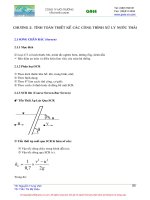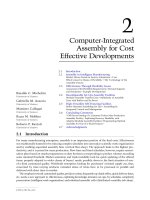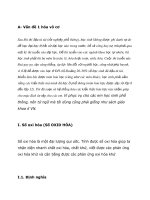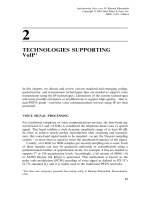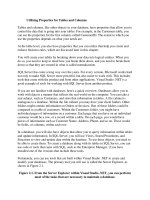Tài liệu Signal Processing for Telecommunications and Multimedia P2 pdf
Bạn đang xem bản rút gọn của tài liệu. Xem và tải ngay bản đầy đủ của tài liệu tại đây (706.14 KB, 20 trang )
18
Chapter 2
where A straight forward approach for BSS is to
identify the unknown system first and then to apply the inverse of the identified
system to the measurement signals in order to restore the signal sources. This
approach can lead to problems of instability. Therefore it is desired that the
demixing system be estimated based on the observations of mixed signals.
The simplest case is the instantaneous mixing in which matrix
is a constant matrix with all elements being scalar values. In practical appli-
cations such as hands free telephony or mobile communications where multi-
path propagation is evident, mixing is convolutive, in which situation BSS is
much more difficult due to the added complexity of the mixing system. The
frequency domain approaches are considered to be effective to separate signal
sources in convolutive cases, but another difficult issue, the inherent permu-
tation and scaling ambiguity in each individual frequency bin, arises which
makes the perfect reconstruction of signal sources almost impossible [10].
Therefore it is worthwhile to develop an effective approach in the time do-
main for convolutive mixing systems that don’t have an exceptionally large
amount of variables. Joho and Rahbar [1] proposed a BSS approach based on
joint diagonalization of the output signal correlation matrix using gradient and
Newton optimization methods. However the approaches in [1] are limited to
the instantaneous mixing cases whilst in the time domain.
3.
OPTIMIZATION OF INSTANTANEOUS
BSS
This section gives a brief review of the algorithms proposed in [1]. Assum-
ing that the sources are statistically independent and non-stationary, observing
the signals over K different time slots, we define the following noise free in-
stantaneous BSS problem. In the instantaneous mixing cases both the mixing
and demixing matrices are constant, that is, and In
this case the reconstructed signal vector can be expressed as
The instantaneous correlation matrix of at time frame can be obtained
as
For a given set of K observed correlation matrices, the aim is to
find a matrix
W
that minimizes the following cost function
2. Time Domain Blind Source Separation
19
where are positive weighting normalization factors such that the cost
function is independent of the absolute norms and are given as
Perfect joint diagonalization is possible under the condition that
where are diagonal matrices due to the assumption of
the mutually independent unknown sources. This means that full diagonal-
ization is possible, and when this is achieved, the cost function is zero at its
global minimum. This constrained non-linear multivariate optimization prob-
lem can be solved using various techniques including gradient-based steepest
descent and Newton optimization routines. However, the performance of these
two techniques depends on the initial guess of the global minimum, which in
turn relies heavily on an initialization of the unknown system that is near the
global trough. If this is not the case then the solution may be sub-optimal as
the algorithm gets trapped in one of the local multi-minima points.
To prevent a trivial solution where W =
0
would minimize Equation (2.11),
some constraints need to be placed on the unknown system W. One possible
constraint is that W is unitary. This can be implemented as a penalty term such
as given below
or as a hard constraint that is incorporated into the adaptation step in the op-
timization routine. For problems where the unknown system is constrained to
be unitary, Manton presented a routine for computing the Newton step on the
manifold of unitary matrices referred to as the complex Stiefel manifold. For
further information on derivation and implementation of this hard constraint
refer to [1] and references therein.
The closed form analytical expressions for first and second order informa-
tion used for gradient and Hessian expressions in optimization routines are
taken from Joho and Rahbar [1] and will be referred to when generating re-
sults for convergence. Both the Steepest gradient descent (SGD) and Newton
methods are implemented following the same frameworks used by Joho and
Rahbar. The primary weakness of these optimization methods is that although
they do converge relatively quickly there is no guarantee for convergence to a
global minimum which provides the only true solution. This is exceptionally
noticeable when judging the audible separation of speech signals. To demon-
strate the algorithm we assume a good initial starting point for the unknown
separation system to be identified by setting the initial starting point of the un-
known system in the region of the global trough of the multivariate objective
function.
20
Chapter 2
4.
OPTIMIZATION OF CONVOLUTIVE BSS
IN THE TIME DOMAIN
As mentioned previously and as with most BSS algorithms that assume con-
volutive mixing, solving many BSS problems in the frequency domain for in-
dividual frequency bins can exploit the same algorithm derivation as the instan-
taneous BSS algorithms in the time domain. However the inherent frequency
permutation problem remains a major challenge and will always need to be
addressed. The tradeoff is that by formulating algorithms in the frequency
domain we can perform less computations and processing time falls, but we
still must fix the permutations for individual frequency bins so that they are
all aligned correctly. This chapter aims to provide a way to utilize the existing
algorithm developed for instantaneous BSS and apply it to convolutive mixing
but avoid the permutation problem.
Now we extend the above approach to the convolutive case. We still assume
that the demixing system is defined by Equation (2.7), which consists of N × M
FIR filters with length Q. We want to get a similar expression to those in the
instantaneous cases. It can be shown that Equation (2.7) can be rewritten in the
following matrix form
where is a (N × QM) matrix given by
and is a (QM × 1) vector defined as
The output correlation matrix at time frame can be derived as
where,
Correlation matrices for the recovered sources for all necessary time lags can
also be obtained as
2. Time Domain Blind Source Separation
21
Using the joint-diagonalization criterion in [1] for the instantaneous mod-
elling of the BSS problem we can formulate a similar expression for convo-
lutive mixing in the time domain. Consider the correlation matrices with all
different time lags we should have the following cost function
The only difference between and is that we now take into account all
the different time lags for the correlation matrices for each respective time
epoch where the SOS are changing. Also is now defined as
and we note the new structure of In the ideal case where we know the
exact system all off-diagonal elements would equal zero and the value
of the objective function would reach its global minimum where Each
value of represents a different time window frame where the Second Or-
der Statistics (SOS) are considered stationary over that particular time frame.
In adjacent non-overlapping time frames the SOS are changing due to the
nonstationarity assumption. As this is a non-linear constrained optimization
problem with NQM unknown parameters we can rewrite it as
Due to the structure of the matrices and with the technique of matrix multi-
plication to perform convolution in the time domain, optimization algorithms
similar to those performed in the instantaneous climate can be utilized. No-
tice also that in the instantaneous version the constraint used to prevent the
trivial solution W =
0
was a unitary one. In the convolutive case a different
constraint is used where the row vectors of are normalized to have length
one. Again referring to the SGD and Newton algorithms closed form analytical
expressions of the gradient and Hessian deduced by Joho and Rahbar [1] are
extended slightly to accommodate the time domain convolutive climate of the
new algorithm. These expressions are shown in Table 2-1. will be
denoted as With these expressions the SGD and Newton methods are
summarized in the Tables 2-2 and 2.3 respectively. Table 2-2 is relatively easy
to interpret as it is a simple iterative update or learning rule with a fixed step
size. As an alternative to a constant step-size the natural gradient method
22
Chapter 2
proposed by Amari [11] could be used instead of the absolute gradient al-
though faster convergence can be expected from second-order methods. Table
2-3 gives the general Newton update with penalty terms incorporated to en-
sure that the Hessian of the constraint, denoted as and the gradient of the
constraint, denoted as are accounted for in the optimization process. Note
the defines the constraint given in Equation (2.22) and expresses the unit
energy of the rows of
2. Time Domain Blind Source Separation
23
5.
SIMULATION RESULTS
To investigate the performance of the extended instantaneous BSS algorithm
to the convolutive case in the time domain the SGD and Newton algorithm im-
plementations in [1] were altered to the learning rules given in Tables 2-2 and
2-3 respectively. As the constraint no longer requires the unknown system
to be unitary the constraint was changed to that given in Equation (2.22). The
technique of weighted penalty functions was used to ensure the constraints
preventing the trivial solution were met. No longer performing the optimiza-
tion on the Stiefel manifold as in [1] the SGD and Newton algorithms were
changed to better reflect the row normalization constraint for the convolutive
case. Using the causal
24
Chapter 2
a first-order two-input-two-output (TITO) two tap FIR known mixing system
was chosen and is given below in the domain as
The corresponding known un-mixing system which would separate mixed sig-
nals which are produced by convolving the source signals with the TITO mix-
ing system given above is
This is the exact known inverse multiple-input-multiple-output (MIMO) FIR
system of the same order. The convolution of these two systems in cascade
would ensure the global system would be a delayed
version of the identity, i.e. Using matrix multiplication to perform con-
volution in the time domain, Equation (2.15) can be used to represent the equiv-
alent structure of Equation (2.24),
Through empirical analysis we set the parameters and and
solve the constrained optimization problem given in Equation (2.22) using the
SGD and Newton methods. A set of K = 15 real diagonal square uncorrelated
matrices for the unknown source input signals were randomly generated. Us-
ing convolution in the time domain a corresponding set of correlation matrices
for each respective time instant at multiple time lags
were generated for the observed signals. Each optimization algorithm was run
ten independent times and convergence graphs were observed and are shown in
Figure 2-1. The various slopes of the different convergence curves of the gra-
dient method depends entirely on the ten different sets of randomly generated
diagonal input matrices. Poor initial values for the unknown system lead to
convergence to local minima as opposed to the desired global minimum. The
initialization of the SGD and Newton algorithms plays an important role in
the convergence to either a local or global minimum. Initial values for the esti-
mated unmixing system were generated using a perturbed version of the true
unmixing system. This was done by adding Gaussian random variables with
standard deviation to the coefficients of the true system. As a possible
alternative strategy, a global optimization routine glcCluster from TOMLAB
[12], a robust global optimization software package, can be used where no
initial value for the unknown system is needed. This particular solver uses a
global search to approximately obtain the set of all global solutions and then
2. Time Domain Blind Source Separation
25
Figure 2-1. Convergence of gradient descent and Newton algorithms for a first order TITO
FIR demixing system over 10 trials.
uses a local search method which utilizes the derivative expressions to obtain
more accuracy on each global solution. This method will be further analyzed
as a future alternative to obtaining additional information on the initial system
value.
After convergence of the objective function to an order of magnitude ap-
proximately equal to the unknown demixing FIR filter system in cas-
cade with the known mixing system resulted in a global system which
was equivalent to a scaled and permuted version of the true global system
I
as can be seen by the following example,
A first order system has been identified up to an arbitrary global permuta-
tion and scaling factor. The TITO system identified above using the optimiza-
tion algorithms has only 8 unknown variables to identify. We now examine a
26
Chapter 2
MIMO FIR mixing system with a higher dimension. Again we have chosen an
analytical MIMO multivariate system whose exact FIR inverse is known. The
3rd order mixing system is given below in the domain
The corresponding known inverse FIR system of the same order is given below
also in the domain as
The convolution of the mixing and unmixing MIMO FIR systems given in
Equations (2.28-2.35) gives the identity matrix I exactly. A comparison of the
convergence behaviour for the more efficient Newton method is given in Fig-
ure 2-2 using the same methods described for the first order systems above,
keeping the learning factor and weighting terms the same. We see from the
figure that with twice as many unknown variables to solve for the demixing
system, the third order unknown system takes longer to converge by roughly
a factor of two. Both systems converge to their global minimums due to good
initialization at approximately For the third order system, one trial pro-
duced an outlying convergence curve that takes more iterations than the other
trials. This is dependent on the randomly generated set of diagonal correlation
matrices where for each trial.
To test the performance of the algorithm on real speech data two indepen-
dent segments of speech were used as input signals to the MIMO FIR mixing
system given in Equation (2.24). These signals were both 4 seconds long and
sampled at 8kHz. The signals were convolutively mixed with the synthetic
mixing system to obtain 2 mixed signals. With the assumption that speech is
quasi-stationary over a period of approximately 20ms, the observed mixed sig-
nals were buffered and segmented into 401 frames each having 160 samples
in length. The nonstationarity assumption assumes that the SOS in each frame
does not change. The correlation matrices can be found via Equations
2
.
Time Domain Blind Source Separation
27
Figure 2-2. Convergence of Newton algorithms for first and third order TITO FIR demixing
systems over 10 trials.
Figure 2-3. (a) and (b) are the two original signals, (c) and (d) are the convolutively mixed
signals, (e) and (f) are the permuted separated results.
(2.18,2.19) for K = 401 frames of the two mixed signals. This allows the
method of joint diagonalization by minimizing the off-diagonal elements of
the correlation matrices of the recovered signals at each respective time lag
28
Chapter 2
as defined in Equations (2.20,2.22). Figure 2-3 shows the input, mixed and re-
covered speech signals. A good qualitative recovery is confirmed by subjective
listening to the recovered audio signals and inspection of graphs (e) and (f) in
Figure 2-3.
6.
CONCLUSION
A new method for convolutive BSS in the time domain using an existing
instantaneous BSS framework has been presented. This method avoids the
inherent permutation problem when dealing with solving the convolutive BSS
problem in the frequency domain. Optimization algorithms including SGD and
Newton methods have been compared for convolutive mixing environments.
Future work will be directed at implementing the simulations with recorded
data such as speech in real reverberant environments where the orders of the
mixing and unmixing MIMO FIR systems are very high.
Acknowledgments
The authors would like to thank the anonymous reviewers for their com-
ments and suggestions. Iain also wishes to thank the support of his mother and
father, Diana and Barry Russell, as well as the patience of his partner Sarah.
REFERENCES
M. Joho and K. Rahbar, “Joint diagonalization of correlation matrices by using New-
ton methods with application to blind signal separation,” in Proc. Sensor Array and
Multichannel Signal Processing Workshop (SAM), Rosslyn, VA, USA, Aug. 2002, pp.
403–407.
K. Rahbar and J. Reilly, “A New Frequency Domain Method for Blind Source Separa-
tion of Convolutive Audio Mixtures,” Submitted to IEEE Trans. on Speech and Audio
Processing, January 2003.
S. Ikeda and N. Murata, “A method of ICA in Time-Frequency Domain,” in Proc.
ICA,
Aussois, January 1999, pp. 365–361.
N. Murata, “An Approach to Blind Source Separation of Speech Signals,” Proceedings
of the 8th International Conference on Artificial Neural Networks, vol. 2, pp. 761–766,
September 1998.
K. J. Pope and R. E. Bogner, “Blind signal separation I: Linear, instantaneous combi-
nations,” Digital Signal Processing, vol. 6, no. 1, pp. 5–16, Jan. 1996.
K. J. Pope and R. E. Bogner, “Blind signal separation II: Linear, convolutive combi-
nations,” Digital Signal Processing, vol. 6, no. 1, pp. 17–28, Jan. 1996.
M. Feng and K D. Kammeyer, “Blind source separation for communication signals
using antenna arrays,” in Proc. ICUPC-98, Florence, Italy, Oct. 1998.
T. Petermann, D. Boss, and K. D. Kammeyer, “Blind GSM Channel Estimation Under
Channel Coding Conditions,” Phoenix, USA, December 1999, pp. 180–185.
1.
2.
3.
4.
5.
6.
7.
8.
2.
Time Domain Blind Source Separation
29
J. Larsen, L. Hansen, T. Kolenda, and F. Nielsen, “Independent Component Analysis
in Multimedia Modelling,” in Proc. ICA, Nara, Japan, April 2003, pp. 687–696.
M. Z. Ikram and D. R. Morgan, “Exploring permutation inconsistency in Blind Sepa-
ration of Speech Signals in a Reverberant Environment,” in Proc. ICASSP, Instanbul,
Turkey, June 2000, pp. 1041–1044.
S. Amari, S. Douglas, A. Cichocki, and H. Yang, “Multichannel blind deconvolution
and equalization using the natural gradient,” Paris, France, April 1997, pp. 101–104,
Proceedings First IEEE Workshop on Signal Processing Advances in Wireless Com-
munications.
Kenneth Holmström, “User’s Guide for TOMLAB v4.0,” URL:
Sept. 2 2002.
9.
10.
11.
12.
This page intentionally left blank
Chapter 3
SPEECH AND AUDIO CODING USING
TEMPORAL MASKING
Teddy Surya Gunawan, Eliathamby Ambikairajah, and Deep Sen
School of Electrical Engineering and Telecommunications, The University of New South
Wales, UNSW Sydney 2052, Australia
Abstract:
This paper presents a comparison of three auditory temporal masking models
for speech and audio coding applications. The first model was developed
based upon the existing forward masking psychoacoustic data with an
assumption of an approximately 200 ms. The model’s dynamic parameters
were derived from this data. The previously developed second model was
based upon the principle of an exponential decay following higher energy
stimuli, where the masking effects have a relatively short duration. The
existing third model best matches the previously reported forward masking
data using an exponential curve but the effects of the forward masking are
restricted to 100-200ms. Objective assessments employing the PESQ measure
reveal that these three temporal models have potential for removing
perceptually redundant information in speech and audio coding applications.
Results show that the incorporation of temporal masking along with
simultaneous masking into a speech/audio coding algorithm results in a further
bit rate reduction of approximately 17% compared with simultaneous masking
alone, while preserving perceptual quality
Key words:
Temporal masking model, Simultaneous masking model, Gammatone filters,
Wavelet Packet, PESQ, Subjective listening test
1.
INTRODUCTION
The use of auditory models in speech and audio coding is by no means
new, and their applications include low bit rate speech coding [1] through to
MPEG audio compression [2]. Conventional audio coding algorithms do not
exploit knowledge of the temporal properties of the human auditory system,
relying solely on simultaneous masking models. Simultaneous masking is a
frequency domain phenomenon in which a low-level signal can be rendered
32
Chapter 3
inaudible by a simultaneously occurring stronger signal if both signals are
sufficiently close in frequency.
Temporal masking is a time domain phenomenon in which two stimuli
occur within a small interval of time [3] This time domain phenomenon
plays an important role in human auditory perception. Post-masking occurs
when a masker precedes the signal in time, while pre-masking occurs when
the signal precedes the masker in time. Post-masking is the more important
effect from a coding perspective since the duration of the masking effect can
be much longer, depending on the duration of the masker.
In this work, we have developed a temporal masking model and
compared its performance using two existing temporal masking models. The
first model developed is based on [4, 5], the second model is based upon [6],
and the third model is based on [7]. The developed temporal masking model
combined with the simultaneous masking model [8] is then used to calculate
the combined masking thresholds in the time-frequency domain. These
models were first incorporated into a critical band based gammatone
auditory filter bank analysis/synthesis system [6] in order to validate the
effectiveness of the model. The models were also included in a wavelet
packet based audio coding algorithm [9] to quantify the improvement for
coding purposes. Results show that the incorporation of temporal masking
along with simultaneous masking into a speech/audio coding algorithm
results in a further reduction of bit rate of approximately 17% while
preserving perceptual quality.
The transparent quality is evaluated using PESQ (Perceptual Evaluation
of Speech Quality) measure [10]. PESQ was recently adopted as an ITU-T
recommendation P.862. PESQ is able to predict subjective quality with good
correlation in a very wide range of conditions, includes coding distortions,
errors, noise, filtering, delay and variable delay. Also subjective
experiments using informal listening tests were carried out in order to assess
the quality of the coded speech and audio signals.
The paper is organized as follows. Section 2 describes the filter bank
analysis for speech and audio coding applications. The temporal masking
models used in this research are explained in section 3. Masking model
performance is evaluated in section 4, while section 5 concludes this paper.
2.
FILTER BANK ANALYSIS
2.1
Gammatone Analysis/Synthesis Filter Bank
Fig. 3-1 shows the gammatone front end processing for speech coding
applications that is applicable to audio coding as the number of filter bank
3. Speech and Audio Coding using Temporal Masking
33
can be increased accordingly. Gammatone filters are implemented using FIR
filters to achieve linear phase filters with identical delay in each critical
band. To achieve linear phase filters, the synthesis filters is the time
reverse of its analysis filters
The analysis filter for each subband m is
obtained using the following expression:
where is the center frequency for each subband m, T is the sampling
period, and N is the gammatone filter order (N = 4). For a sampling period
of 8000 Hz, the total number of subband is M = 17, so m = 1 17. The
parameter n is the discrete time sample index and
where
is
the length of each filter for each subband.
is the equivalent
rectangular bandwidth of an auditory filter. At a moderate power
level,
The parameter b is set to 1.14 while the
parameter a is set for each subband to normalize the filter gain to 0 dB.
Figure 3-1. Gammatone analysis and synthesis filter bank
34
Chapter 3
The analysis filter bank output is followed by a half-wave rectifier to
simulate the behavior of the inner hair cell. Moreover, the nature of the
neuron firing allows a simple peak-picking implementation. This process
results in a series of critical band pulse trains, where the pulses retain the
amplitudes of the critical band signals from which they were derived The
masking operation is then applied to the pulses, in order to remove the
perceptually irrelevant peaks.
2.2
The PESQ measure
Formal listening tests must meet several conditions especially the
characteristics of listening rooms (ITU-R BS.1116) that require special
equipment. Therefore, in this research work we use an informal listening test
confirmed by the PESQ measurement system [10] as the tools for evaluating
the speech quality.
PESQ has recently been approved as ITU-T recommendation P.862 in
February 2001 as a tool for assessing speech quality. The input to the PESQ
software tool is the reference speech signal and the processed speech signal.
The PESQ then rates the speech quality between 1.0 (bad) and 4.5 (no
distortion). However, the informal listening tests revealed that the PESQ
score of 3.5 provides transparent speech quality.
2.3
Optimum Number of Filter Coefficients
Figure 3-2. Variation of PESQ score with number of filter coefficients
3. Speech and Audio Coding using Temporal Masking
35
The number of coefficients required to implement the analysis/synthesis
filter bank depends on the impulse response of the gammatone filters. The
low frequency filters need more coefficients as compared to the high
frequency filters. It is possible to estimate the optimum number of
coefficients required for the analysis/synthesis filter bank with peak picking
operation, using the PESQ software tool. It is assumed that filters with a
constant delay across all bands are required in the analysis stage for time-
aligning critical band pulses across different bands. Fig. 3-2 shows PESQ
measure against the number of filter coefficients and it can be seen that
(corresponds to 15 ms delay in 8 kHz sampling rate) provides
maximum PESQ score. Hence, the optimum value is used in this paper.
3.
TEMPORAL MASKING MODELS
In this section, we present the equations required to implement our
temporal forward masking model along with the other existing temporal
forward masking models. Backward masking models are not considered
here, as their effects in coding applications are somewhat limited.
3.1
Model 1 (TM1)
Jesteadt et al. [4] describe temporal masking as a function of frequency,
masker level, and signal delay. Based on the forward masking experiments
carried out by [4], the amount of temporal masking can be well-fitted to
psychoacoustic data using the following equation:
where is the amount of forward masking (dB) in the mth band,
is the time difference between the masker and the maskee in milliseconds,
L(t,m) is the masker level (dB), and a, b, and c, are parameters that can be
derived from psychoacoustic data.
Najafzadeh et al. [5] incorporated the temporal masking model above to
the MPEG psychoacoustic model in which they achieve a significant coding
gain. Nevertheless, the temporal masking model 1 proposed is based on [4,
5] with several modifications of the parameters a, b, and c.
The parameter a is based upon the slope of the time course of masking,
for a given masker level. We have approximated a by curve-fitting of the
psychoacoustic data in [4], as follows:
36
Chapter 3
where is the center frequency of the critical band m, and have
values 0.5806, -0.0357 and 0.0013, respectively.
Assuming that forward temporal masking has duration of 200
milliseconds, and thus b may be chosen as [5]. Similarly to the
calculation of parameter a, the parameter c is chosen by fitting a curve to the
masker level data provided in [4]:
where values are 6.6727, 2.979 and -0.11226 respectively. The final
value of c is obtained by adding the threshold of hearing [11]. This means
that any signal components below the threshold of hearing will automatically
be masked.
Figure 3-3. Efficient masking threshold calculation
The calculation of the masker level can be performed over many frames
to accumulate a reliable estimate. However the number of frames may
depend on the coding application. In this instance, where experiments on
speech were performed, we have developed an efficient method for masking
calculation as shown in Fig. 3-3.
The current frame of 16 ms was subdivided into four sub-frames, and the
forward masking level was calculated for the jth sub-frame using
the energy accumulated over the previous frame and all sub-frames up to the
current sub-frame. The amount temporal of masking TM1 is then chosen as
the average of over j calculated using This masking
calculation is more efficient than the original method proposed in [5] as they
calculated the masking threshold for every sample in a frame, while we
calculate the threshold only four times per frame. Calculation of a temporal
masking threshold every 4 ms was considered adequate since this provides a
good approximation to the decay effect that lasts around 200 ms.
3. Speech and Audio Coding using Temporal Masking
37
3.2
Model 2 (TM2)
The second model developed by Ambikairajah et al. [6] is based on the
fact that temporal masking decays approximately exponentially following
each stimulus. The masking level calculation for the mth critical band signal
is
where The amount of temporal masking TM2 is then
chosen as the average of for each sub-frame calculation.
Normally first order IIR low-pass filters are used to model the forward
masking [6, 12]. We have modified the time constant, of these filters as
follows, in order to model the duration of forward masking more accurately.
The time constants and used were 8 ms and 30 ms, respectively.
The time constants were verified empirically by listening to the quality of
the reconstructed speech, and were found to be much shorter than the 200 ms
post-masking effect commonly seen in the literature.
3.3
Model 3 (TM3)
Novorita [7] incorporated temporal masking effects into bark spectral
distortion measure used for automatic speech quality measurement. Novorita
analyzed four masking filters, including exponential, linear, second power
and half power, and concluded that temporal masking models conforming to
the exponential responses achieved the best performance.
The temporal masking filter with exponential decay used by [7] is as
follows:
where n is short-time frame index, is time offset index, m is the critical
band number in Barks, is the value in phons for a given bark and time
point, au_min is the convergence point for threshold response decay, and eq
is a factor to normalize the time constant.

